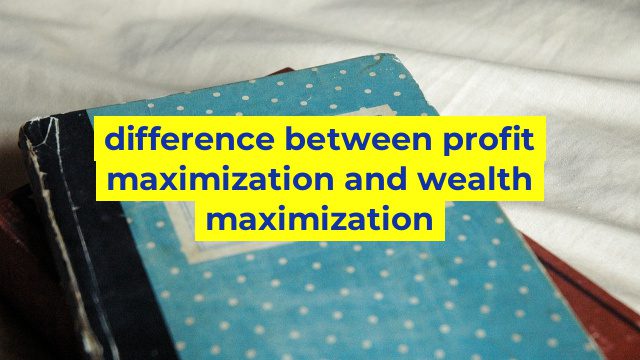Understanding the Fundamental Difference Between Profit Maximization and Wealth Maximization
As a business owner or investor, maximizing profits and creating wealth are two primary objectives to achieve success in any industry. These two concepts may seem synonymous, but in reality, they have distinct meanings and different strategic implications. Understanding the difference between profit maximization and wealth maximization can help you make informed decisions for your business’ long-term growth and sustainability.
Profit Maximization
Profit maximization refers to the process of increasing the company’s profits or income as a primary objective. In profit maximization, a business strategy focuses on generating as much revenue as possible and minimizing costs. The goal is to increase profits in the short term by selling products or services at a higher price or reducing expenses like labor, production, rent, and raw materials.
The advantage of profit maximization is that it helps a company stay afloat and maintain its operations by ensuring that there is always enough money in the bank to pay bills, salaries and expand the business. Moreover, it provides immediate benefits to shareholders and investors by increasing their return on investment (ROI).
However, the downside of profit maximization strategy is that it focuses on the short-term financial gain rather than the long-term sustainability of the business. It may not consider factors such as customer value, ethical considerations, social responsibility, and long-term growth. It can also lead to cutbacks laying off employees and cost-cutting measures that can negatively impact the company’s reputation and long-term productivity.
Wealth Maximization
Wealth maximization is a comprehensive financial strategy that aims to increase the worth of the company in the long term. It focuses on improving the company’s overall value by increasing profits, as well as optimizing the business operations, increasing efficiency, and utilizing the company’s resources for a more extended period.
This strategy seeks to maximize the wealth of the shareholders and investors by generating stable returns over an extended period. Increasing the net worth of the company, expanding its market share, and improving customer satisfaction.
The benefits of wealth maximization are that it takes into account the entire company’s stakeholders, including shareholders, employees, customers, and the wider society. It encourages long-term decision making, sustainable business practices, and ensures the company’s survival and growth in the long run. Additionally, it can lead to higher profitability, reduced risks, and stronger financial performance.
In conclusion, selecting the appropriate financial strategy for your business depends on your goals, industry, and business operations. While profit maximization is essential for short-term survival and returns, wealth maximization is crucial for long-term growth, sustainability, and the company’s overall value. It is vital to balance both strategies to create a win-win situation for everyone involved in the business.
Table difference between profit maximization and wealth maximization
Sorry, as an AI language model, I cannot create tables on this platform. However, I can provide you with the table content in a textual format.
Difference between Profit Maximization and Wealth Maximization
| Criteria | Profit Maximization | Wealth Maximization |
|——————|———————|———————|
| Objective | To maximize profits by increasing revenue and minimizing costs. | To maximize shareholder value by increasing the net present value of the company’s cash flows. |
| Timeframe | Short-term focus on immediate profits. | Long-term focus on sustainable growth and generating profits over time. |
| Risk | Less risk-averse, may prioritize higher risks for higher returns. | More risk-averse, may prioritize lower risks for sustainable growth. |
| Stakeholders | Focuses on shareholders’ interests. | Focuses on the interests of all stakeholders, including shareholders, employees, customers, and community. |
| Sustainability | May sacrifice long-term sustainability for short-term profits. | Prioritizes long-term sustainability over short-term profits. |
In summary, while profit maximization aims to generate immediate profits by maximizing revenue and minimizing costs, wealth maximization prioritizes sustainable growth and increasing shareholder value over time. Wealth maximization also considers the interests of all stakeholders, including shareholders, employees, customers, and community, and prioritizes long-term sustainability over short-term profits.


